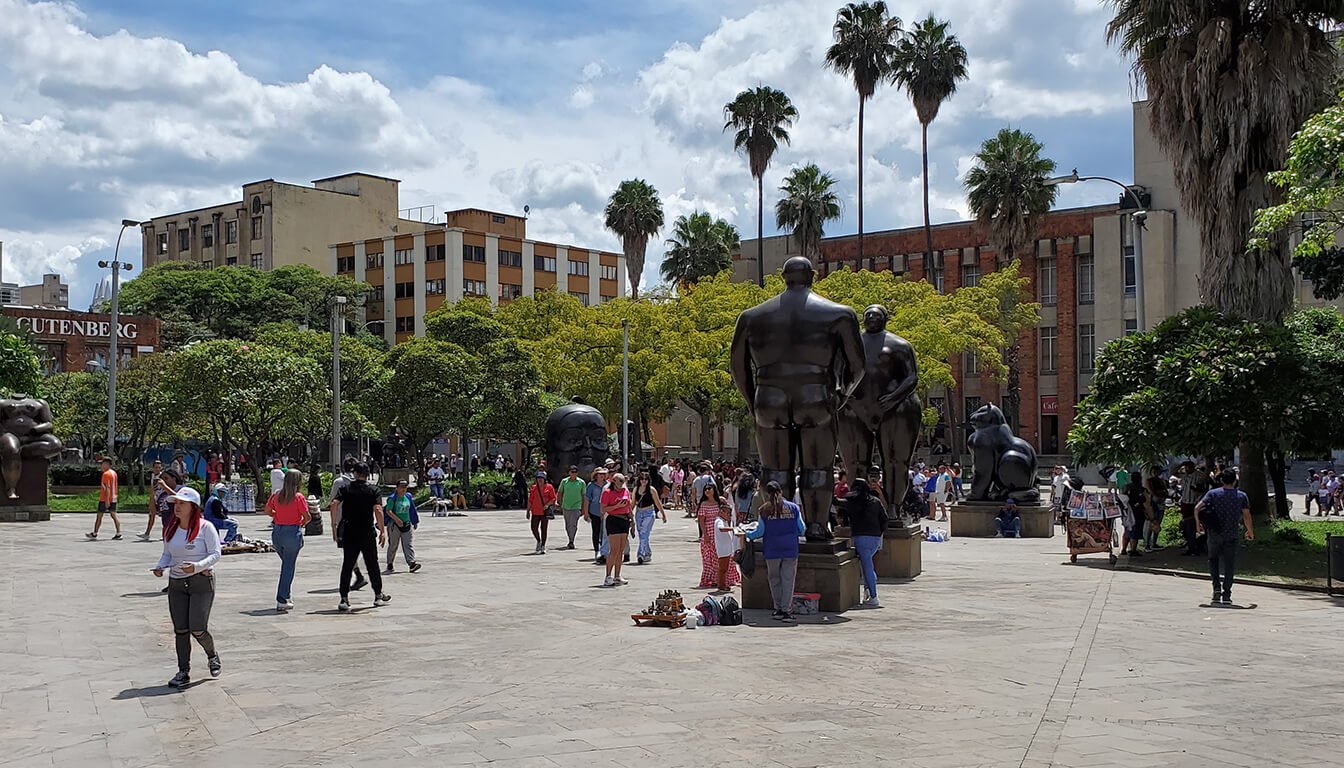South America is experiencing rapid urbanization and development, with several cities emerging as hotspots of growth and opportunity. In this article by Medellin.co, we will explore the rise of these dynamic cities, examining their transformation, economic prospects, and the factors driving their rapid expansion. From the exciting streets of Medellín to the changing urban landscape of Buenos Aires, these cities offer a vision of the future of South American development.
Key Takeaways:
- Medellin, Cartagena, Lima, Buenos Aires, and Rio de Janeiro are the top 5 fastest growing cities in South America in 2024.
- Factors driving their rapid expansion include socio-economic and cultural influences, innovation, infrastructure development, economic opportunities, and increasing investor interest.
- These cities present immense potential for further growth and development, offering a range of opportunities for businesses and individuals alike.
- Their rise highlights South America’s increasing prominence on the global stage.
- Exploring the growth and transformation of these cities provides valuable insights into the future of urban development in the region.
The Rise of Medellin
Medellin, Colombia’s second-largest city, has undergone a remarkable transformation in recent years, overcoming decades of violence and insecurity to position itself as one of South America’s fastest-growing cities. With its rich cultural heritage, breathtaking scenery, and vibrant local economy, Medellin has become a thriving center for innovation, tourism, and investment opportunities in 2024.
One of the driving factors behind Medellin’s rapid growth is its commitment to urban development and infrastructure. The city has invested heavily in modernization projects, including the development of an efficient public transportation system. The iconic Metrocable, a cable car system that connects the city’s hilly neighborhoods, has not only improved accessibility but also served as a symbol of Medellin’s rise from a troubled past to a city of progress and inclusivity.
The city’s dedication to innovation and entrepreneurship has also contributed to its upward trajectory. Medellin is home to several renowned universities and a vibrant tech and textile industry, attracting talented individuals from around the world. The city’s thriving startup ecosystem has fostered innovation and created countless job opportunities, further fueling its growth.
The Mayor’s office of Medellin has established tax incentives for companies in the tech and communications sector to strengthen Medellín as the Software Valley. As part of this effort, Sapiencia is providing specialized training for the Fourth Industrial Revolution and plans to award 50,000 scholarships in related fields to support this initiative.
Beyond its economic growth, Medellin has also prioritized social development and inclusivity.
The city’s neighborhood revitalization projects, such as the iconic Comuna 13, have transformed previously marginalized areas into vibrant cultural hubs. Medellin’s commitment to social inclusion has garnered international recognition, with the city winning in 2016 the prestigious Lee Kuan Yew World City Prize for its innovative urban transformation efforts.
According to the ACI, Medellín, the capital of Antioquia, is one of the best cities in Colombia for business regulatory climate. The city contributes to 12% of new business creation in Colombia, only surpassed by Bogotá. This data showcases the city’s favorable conditions for entrepreneurship and economic development.
As Medellin continues to attract visitors, entrepreneurs, and investors, its potential for further growth and development remains promising. With the government’s ongoing efforts to create a conducive environment for business and tourism, Medellin is poised to solidify its position as one of the most dynamic and fastest-growing cities in South America.
Exploring the Expansion of Cartagena
Cartagena, located on the northern coast of Colombia, is experiencing significant growth and expansion, making its mark as one of the fastest-growing cities in South America. This vibrant and historically rich destination has captured the attention of travelers and investors alike, fueling its rapid development.
The expansion of Cartagena can be attributed to several key factors. Firstly, its strategic geographical location plays a crucial role. Situated on the Caribbean Sea, the city boasts beautiful beaches and a thriving port, making it a hub for international trade and tourism.
In 2022, Bolívar’s Gross Domestic Product (GDP) reached $35.4 trillion COP, contributing 3.6% to the national total and ranking as the eighth department that contributed the most to the generation of GDP in Colombia. Moreover, it was the seventh-highest contributor to the increase in Colombia’s GDP compared to 2021.
Bolívar is the seventh largest exporting department, originating almost 6% of Colombia’s exports. Furthermore, Cartagena has the most important customs office in Colombia, handling 33% of the tonnes exported in the country, which represents 46% of the revenue from national exports. In 2022, a total of 41.6 million tonnes were mobilized in Cartagena, equivalent to one in every four tonnes mobilized in the country.
Cartagena’s port area stands as the most important in Colombia, surpassing 35% of the tonnes mobilized by the port area of Ciénaga, which occupies the second place. This data illustrates the crucial role Cartagena plays in the economic structure of both the department of Bolívar and Colombia as a whole.
Finally, Cartagena’s tourism industry has experienced exponential growth in recent years. The city offers a wide range of luxurious hotels, world-class restaurants, and exciting entertainment options, catering to the needs of national and international travelers.
Lima: A City on the Rise
In recent years, Lima the capital of Peru has emerged as one of the fastest-growing cities in South America, with growth over the last decade of 3.8%. The city’s transformation and progress have been remarkable, making it a hotspot for investors and tourists alike. Lima embodies the essence of a modern metropolis while retaining its rich cultural heritage.
Lima’s rapid growth can be attributed to several factors. Firstly, its strategic location on the Pacific coast has facilitated trade and commerce, attracting businesses from around the world. The city serves as a gateway to the rest of South America and has established itself as a central economic hub.
Furthermore, Lima has made significant investments in infrastructure development, improving connectivity and enhancing the overall quality of life for its residents. The city boasts a modern transportation system, state-of-the-art airports, and world-class educational institutions.
The private sector in Peru has received support from the International Finance Corporation (IFC) in various areas. This includes financing and consulting for infrastructure development, as well as assistance to strengthen the capabilities of regional and municipal governments. An example of this is the shared value platform “Moquegua Crece,” a partnership with shareholders of the mining company Quellaveco, as well as the regional government of Moquegua.
Furthermore, the IFC has established credit lines with banking institutions to support micro, small, and medium-sized enterprises (SMEs). These efforts are mainly focused on promoting financial inclusion for women and migrant populations. Such initiatives are boosting economic growth in Peru by fostering a more inclusive and robust private sector that can drive sustainable development.
Lima also benefits from a thriving tourism industry. The city is known for its stunning architecture, including the historic center, which has been designated as a UNESCO World Heritage Site. Visitors flock to Lima to experience its fascinating culinary scene, which has earned the city a reputation as the gastronomic capital of South America.
Buenos Aires: Evolving Urban Landscape
Buenos Aires, the capital of Argentina, is undoubtedly one of the fastest-growing cities in South America. Its evolving urban landscape is a testament to the city’s dynamic development and ever-increasing opportunities for residents and businesses alike.
Located on the southeastern coast of South America, although the country is one of the countries with the highest inflation, Buenos Aires continues to promote a stable, diversified, competitive, and open economy to the world.
One of the notable aspects of Buenos Aires’ urban landscape is its blend of architectural styles. From the iconic colonial buildings in the historic neighborhoods of San Telmo and La Boca to the sleek modern structures in the business district of Puerto Madero, the city showcases a rich tapestry of architectural diversity.
The Province of Buenos Aires accounts for over a third of the national gross domestic product and total exports while also contributing 40% to the national tax revenue. It represents approximately half of the country’s industrial activity. Therefore, the evolution of its economy is not only significant for the people living in the province but also crucial for the national economic performance.
In the first seven months of 2023, vehicle production increased by 11.8%, while iron, steel, and cement saw increases of 2%, 4.4%, and 11.1% respectively. Commenting on these developments, Minister Pablo López noted: “The strong performance of strategic industries, such as automotive and construction, indicates that the Province places a central role on production and employment.” This data highlights the robust growth and critical role of Buenos Aires in Argentina’s overall economic landscape.
Rio de Janeiro: A City of Vibrant Growth
Rio de Janeiro, located in Brazil, is the final city on our list of fastest-growing cities in South America, experiencing vibrant growth and development. Known for its stunning natural beauty, culture, and thriving economy, Rio de Janeiro has become a magnet for both domestic and international investors.
One of the key drivers of Rio de Janeiro’s growth is its robust tourism industry. This sector contributes more than US$3.2 billion to Rio de Janeiro’s GDP, which corresponds to 3% of its total economy. The city is home to world-famous attractions such as the iconic Christ the Redeemer statue, Copacabana and Ipanema beaches, and the vibrant Carnival festival. These attractions draw millions of visitors each year, contributing to the city’s economic prosperity.
In recent years, Rio de Janeiro has also seen significant investments in infrastructure and urban development. The city has undergone extensive renovations in preparation for major global events such as the FIFA World Cup in 2014 and the Olympic Games in 2016. This investment in infrastructure has not only enhanced the city’s image but also created new opportunities for businesses and residents.
Moreover, In December 2023, Rio de Janeiro ranked second in total exports and third in total imports in Brazil, demonstrating its significant role in the country’s trade landscape. Regarding exports, Rio de Janeiro exported $45.5 billion in 2023, making it the second-largest exporter among the 27 exporting entities in Brazil. Its main exports included petroleum oils and minerals ($36.1 billion), semi-finished iron or steel bars ($2.39 billion), light petroleum distillates ($1.83 billion), non-pyrite iron ore concentrate ($910 million), and semi-finished alloy steel products ($562 million).
With its combination of natural beauty, cultural vibrancy, economic opportunities, and exportation, Rio de Janeiro continues to position itself as one of the fastest-growing cities in South America. As the city strives for continued development, it will undoubtedly attract even more attention and investment in the years to come.
Innovation and Infrastructure Development
One of the key driving factors behind the rapid growth of the fastest-growing cities in South America is the emphasis on innovation and infrastructure development. These cities have recognized the importance of staying ahead in a globalized world and have prioritized investments in innovative technologies and robust infrastructure.
The integration of innovative solutions into various sectors has paved the way for advancements in healthcare, education, transportation, and urban planning. By leveraging technology and embracing innovative practices, these cities are able to provide their residents with improved quality of life and increased economic opportunities.
The development of modern infrastructure plays a crucial role in attracting businesses, investors, and talent to cities. A well-connected transportation network, state-of-the-art airports, and advanced logistics systems make cities attractive hubs for trade and commerce. Upgraded infrastructure facilitates the efficient flow of goods and services, which leads to economic growth and development.
Overall, the commitment to innovation and infrastructure development in the fastest-growing cities in South America sets the stage for continued progress and prosperity. By fostering an ecosystem of innovation and providing the necessary foundation for growth, these cities are well-positioned to attract investment talent and become global leaders in various industries.
Economic Opportunities and Investor Interest
The rapid growth of the fastest-growing cities in South America has presented a plethora of economic opportunities for both residents and businesses alike. With their thriving economies and expanding industries, these cities have become hotspots for entrepreneurs, investors, and multinational corporations seeking to capitalize on the region’s potential.
From burgeoning tech startups to booming real estate markets, the economic landscape of these cities has attracted significant investor interest. As the population grows and consumer spending power increases, innovative businesses in various sectors, such as technology, tourism, and renewable energy, have emerged, creating a favorable investment climate.
The availability of skilled labor and favorable government policies geared towards attracting foreign investment has further fueled investor interest in these cities. Government initiatives supporting entrepreneurship, infrastructure development, and tax incentives have contributed to an environment conducive to business growth and profitability.
Furthermore, the strategic location of these cities, coupled with improved transportation networks and logistics infrastructure, has enhanced their accessibility and connectivity to global markets. Investors recognize the potential for high returns on their investments due to the cities’ strategic positioning in South America’s economic landscape.
Diversification and Risk Mitigation
Investors are drawn to the fastest-growing cities in South America not only for their economic opportunities but also for their potential to diversify investment portfolios and mitigate risk. By investing in multiple cities within the region, investors can reduce their exposure to volatility in individual markets and take advantage of the varying growth trajectories in different industries.
Additionally, diversification across sectors and asset classes helps investors navigate economic cycles and ensure long-term sustainability. These cities offer a range of investment options, from real estate and infrastructure projects to technology startups and venture capital funds.
The Future of Investment in South America
The economic opportunities and investor interest in the fastest-growing cities in South America show no signs of slowing down. As these cities continue to attract investment and foster innovation, they position themselves as key players in the global economy.
Investors who recognize the potential of these cities and seize the economic opportunities they offer stand to gain substantial returns on their investments while also contributing to the continued growth and prosperity of these vibrant urban centers.
FAQs
- What are the fastest-growing cities in South America in 2024?
The top 5 fastest growing cities in South America in 2024 are Medellin, Cartagena, Lima, Peru, Buenos Aires, and Rio de Janeiro.
- Why is Medellin considered one of the fastest-growing cities in South America?
Medellin has experienced rapid growth and development due to its thriving economy, innovative urban planning, and investment in infrastructure.
- What factors have contributed to the expansion of Cartagena?
The expansion of Cartagena can be attributed to factors such as its strategic location, tourism boom, and government initiatives to attract investments.
- How has Lima transformed into one of the fastest-growing cities in South America?
Lima has undergone a significant transformation through urban development projects, economic reforms, and increased international investments, making it one of the fastest-growing cities in South America.
- What makes Buenos Aires an evolving urban landscape?
Buenos Aires is considered an evolving urban landscape due to its architectural renaissance, cultural vibrancy, and commitment to sustainable development.
- Why is Rio de Janeiro known for vibrant growth?
Rio de Janeiro has a reputation for vibrant growth due to its booming tourism industry, investment in infrastructure for significant events, and urban revitalization projects.
- What are the key factors driving the rapid expansion of the fastest-growing cities in South America?
The rapid expansion of these cities is driven by factors such as increasing urbanization, economic opportunities, favorable business environments, and government support for development.
- What economic opportunities and investor interest are fueling the growth of the fastest-growing cities in South America?
The fastest-growing cities in South America offer a range of economic opportunities in sectors such as technology, real estate, tourism, and manufacturing, attracting both domestic and international investors.
















